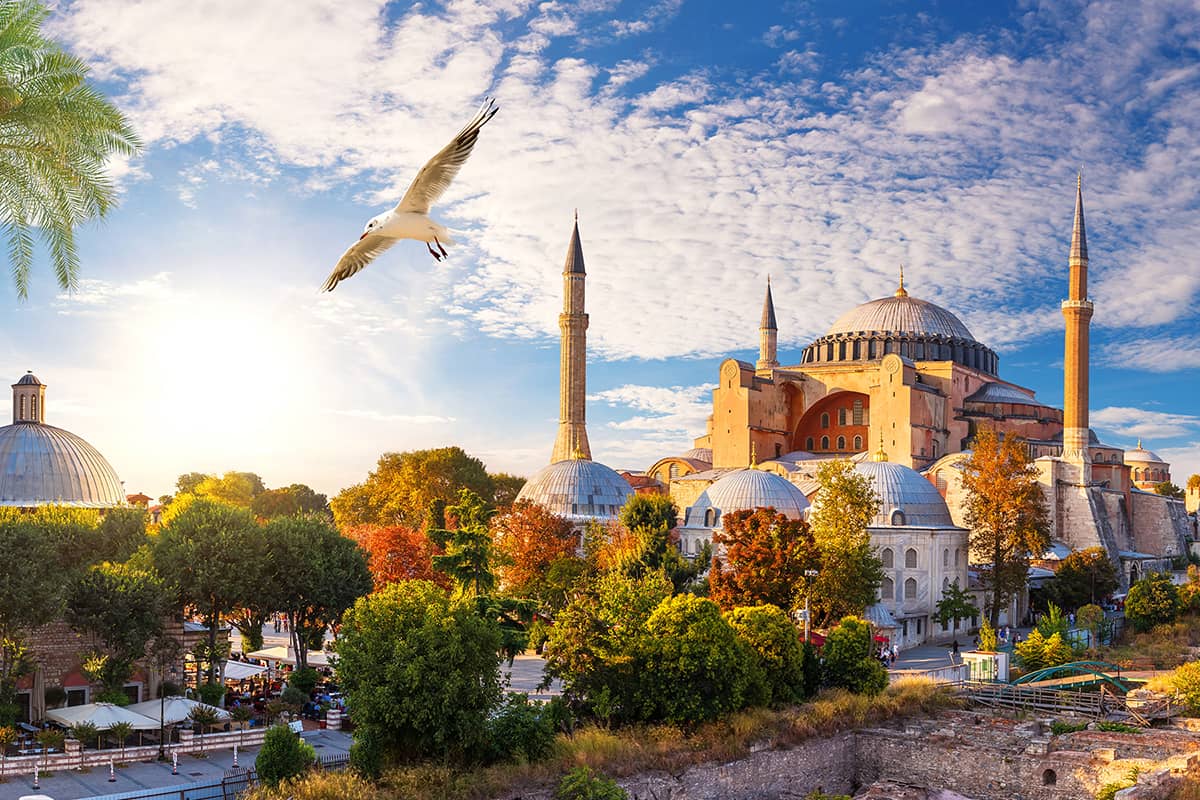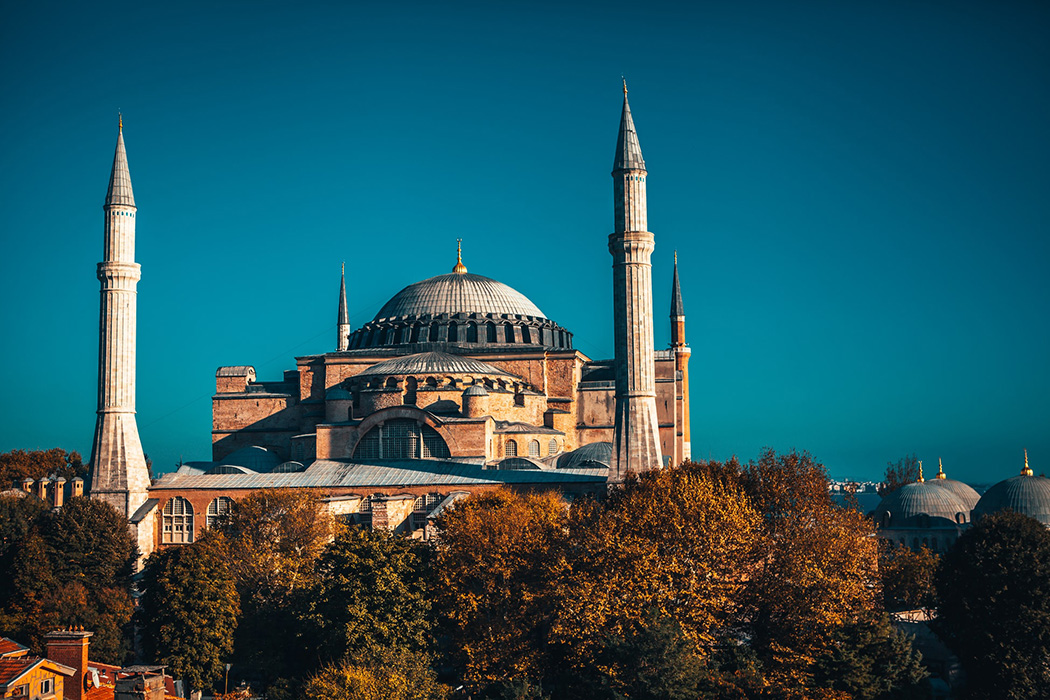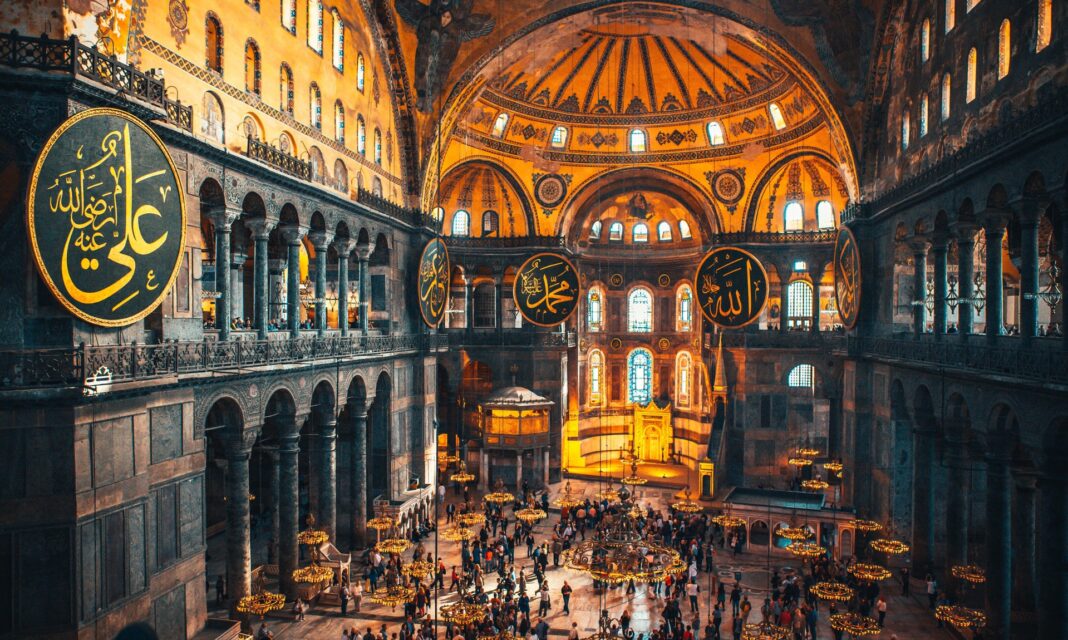Istanbul has many historical and touristic landmarks, and this is not new, yet there is a landmark when it’s asked the tourists what they think when we say Istanbul. Probably one of the most popular answers is Hagia Sophia. Hagia Sophia is located in Fatih, Istanbul. The mosque which has a huge history, more than one owner, and its glorious ornamentation is a perfect choice on your to-do list.

Hagia Sophia’s History
Hagia Sophia, a newly became mosque, was built in Constantinople (Istanbul) by Byzantine Empire. Byzantine Emperor Justinianus I had the basilica built in the years between 532-537. The mosque which had been completed in 5 years, had cost more than 20 million golden drahmas, which equals to over 400 million Euros. It was a significant center of religious, political, and aesthetic for the locals at that time. It was not built just for worshipping, that’s why, it consists of tombs, a library, a fountain, a clock room, a library, and more. This sophisticated structure of the Hagia Sophia Mosque makes it an important treasure for its people.
In 1453, Ottoman Empire’s Sultan Mehmed II conquered Constantinople and converted Hagia Sophia Basilica to Hagia Sophia Mosque. When he took the city, the basilica was ruined. He ordered the basilica renovate and a minaret was added to the building. Hence, the ornaments of the Hagia Sophia have remained. The other minaret had been added by Sultan Bayazid II. Sultan Mehmed II had Hagia Sophia Mosque add 4 minarets, a fountain for performing ablution, a chandelier, a mihrab, and a pulpit. The other minaret had been added by Sultan Bayazid II. Then, Sultan Suleiman the Magnificent brought two oil lamps from the Hungary voyage. These oil lamps are still located there. Between 1566-1574, the building seemed like it has no strength. Sinan the Architect strengthened the mosque using buttresses and added two more minarets, a madrasah, and a mihrab. Then, Istanbulites used Hagia Sophia as a mosque until 1935.
In 1923 Ataturk declared the republic in Turkey and abolished the old sultanate. After that period, the government was trying to establish secularism in the country and abolish the marks of the old theocratic state. They were making effort to convert to a church again, however, there were not enough Christians in that area, and this decision would make Muslim residents upset. That’s why government officers converted it into a museum. Then, it was added to UNESCO World Heritage List in 1985. In 1991, under the rule of Turgut Özal in Turkey, one part of the museum was opened for prayer. The idea of becoming a mosque again started in 2005. However, that idea became serious in 2008. Making a religious Tv programme in front of the Hagia Sophia, calling azan at morning prayer, etc. brought to mind the thoughts of converting the museum to the mosque again. This thought became an agenda of its times and in 2020 Hagia Sophia Museum became Hagia Sophia Mosque.
Ornaments of Hagia Sophia
The architecture of Hagia Sophia can be interpreted from a lot of perspectives, hence, the most known ornament is Hagia Sophia’s mosaics. They were made of mostly gold, silver, stained glass, terra-cotta, and colored marble stone. These mosaics depict important figures like Mother Mary, Jesus, Archangel Gabriel, and Emperor Constantine.
One of the most important mosaics is The Apse Mosaic. In that mosaic, Mother Mary holds Jesus on her lap and her one hand is on his shoulder. It was made in the 9th century.
The other one is Angel Figures. On the dome, there are 4 angels, every angel is similar to the other. All of the angels were made of mosaics, however, on the west side, the angels degenerated, and they were renovated using mural painting.
The third one is Deesis. On the figure, Mother Mary, Jesus, and İoannes Prodromos are seen. The figure depicts the scene of Mother Mary and Ioannes Prodromos are begging Jesus to forgive humanity. Deesis drew attention through its mosaic techniques and its style. The Colour choices and shine of the faces are easily realized.
The fourth one is Komnenos Mosaics. On that mosaic, the emperor Ioannes Komnenos II, his wife, and Mother Mary are symbolized. Mother Mary holds Jesus in her arms.
The fifth one is Leon VI. Mosaics. These mosaics depict Jesus sitting on a throne, holding Bible in his left hand. On the right side of the mosaic, in a circle, there is the figure of Gabriel, on the left side, there is Mother Mary. Emperor Leon VI is lean on the feet of Jesus. These mosaics are the most important ones that everyone should see them. Even if they have been plastered from time to time, some of the mosaics still can be seen. In that way, Hagia Sophia can be assumed still as a museum.

How to visit Hagia Sophia?
Hagia Sophia Mosque is open 24 hours and you can visit there every day. Yet after 12:00 people come for the noon prayer, so if you visit the hours between 08:00-12:00, you will find the mosque calm. A good thing there is no entrance fee for Hagia Sophia. If you wish to learn the prayer times, you can check it out at namazvakitleri.diyanet.gov.tr. Also, there is not a particular rule for the dress code, but you better wear long-armed shirts and pants. If you do not bring your headscarf, it is OK, probably you will find it inside the mosque. In short, Hagia Sophia is a wonderful place to visit on your Istanbul trip.
Boats rentals are waiting for you at Teknevia for those who want to enjoy the sea more in Istanbul.
